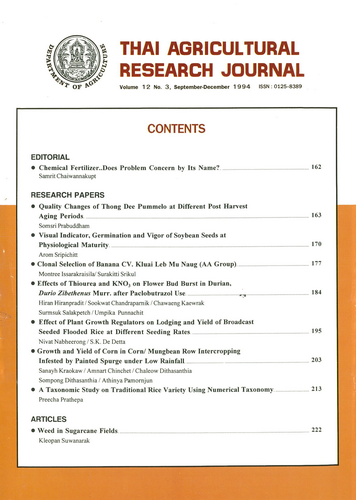A Taxonomic Study on Traditional Rice Variety Using Numerical Taxonomy
DOI:
https://doi.org/10.14456/thaidoa-agres.1994.24Keywords:
statistical model, classification, cluster analysisAbstract
The aim of the present investigation was to construct the statistical model for classification rice varieties by means of discriminant and cluster analysis in 42 traditional rice varieties. During 1993 wet season (Jun-Dec), the pot experiment was laid out in completely randomized design with three replications and 16 morphological characters of rice plants and grain shape were recored and analyzed.Result of the study showed that two different types of coleoptile were found to be a character to distinguish between two groups of the rice varieties, and there was highly significant positive correlation between the coleoptile and six morphological characters. From the results of discriminant analysis, the rice varieties can be divided into two groups based on the coleoptile types by six morphological character. The startistical modek, Canonical discriminant function showed highly significant to discriminate between the two groups. Furthermore, it express highly efficient when determine the predicted group membership with 97.62 percent of grouped cases correctly classified.As a result of cluster analysis, a dendrogram was ue to describe similarity and dissimilarity among rice variety groups by the rescaled distance cluster combine.
Downloads
Published
How to Cite
Issue
Section
License

This work is licensed under a Creative Commons Attribution-NonCommercial-NoDerivatives 4.0 International License.
Thai Agricultural Research Journal



